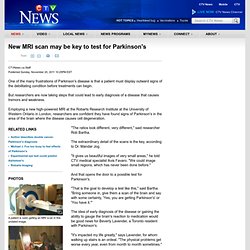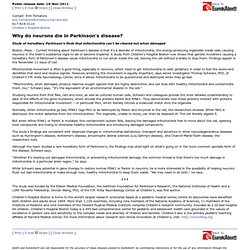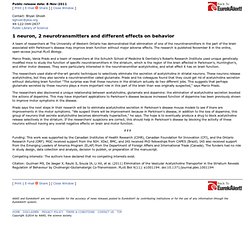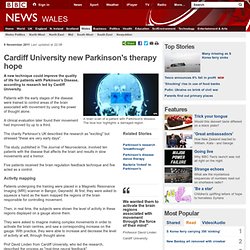

News - New MRI scan may be key to test for Parkinson's. One of the many frustrations of Parkinson's disease is that a patient must display outward signs of the debilitating condition before treatments can begin.

But researchers are now taking steps that could lead to early diagnosis of a disease that causes tremors and weakness. Employing a new high-powered MRI at the Robarts Research Institute at the University of Western Ontario in London, researchers are confident they have found signs of Parkinson's in the area of the brain where the disease causes cell degeneration. "The ratios look different, very different," said researcher Rob Bartha. The extraordinary detail of the scans is the key, according to Dr. Mandar Jog. "It gives us beautiful images of very small areas," he told CTV medical specialist Avis Favaro. And that opens the door to a possible test for Parkinson's. "That is the goal to develop a test like this," said Bartha. "It's impacted my life greatly," says Lavender, for whom walking up stairs is an ordeal. DBS: Increasing the efficacy of deep brain stimulation for Parkinson's disease with novel temporal patterns of stimulation.
Why do neurons die in Parkinson's disease? Public release date: 10-Nov-2011 [ Print | E-mail Share ] [ Close Window ] Contact: Erin Tornatoreerin.tornatore@childrens.harvard.edu 617-919-3110Children's Hospital Boston Boston, Mass. - Current thinking about Parkinson's disease is that it's a disorder of mitochondria, the energy-producing organelles inside cells, causing neurons in the brain's substantia nigra to die or become impaired.

A study from Children's Hospital Boston now shows that genetic mutations causing a hereditary form of Parkinson's disease cause mitochondria to run amok inside the cell, leaving the cell without a brake to stop them. Findings appear in the November 11 issue of Cell. Mitochondrial movement is often a good thing, especially in neurons, which need to get mitochondria to cells' periphery in order to fuel the axons and dendrites that send and receive signals.
Normally, when mitochondria go bad, PINK1 tags Miro to be destroyed by Parkin and enzymes in the cell, the researchers showed. . [ Print | E-mail. Neuroderm succeeds in Parkinson's patch trial. Sources inform ''Globes'' that Neuroderm Ltd. has achieved promising results in the primary endpoint of its Phase II clinical trial of ND0611, a carbidopa patch for treating Parkinson’s disease.

The drug delivery patch would improve the availability of orally administered levodopa. Oral levodopa is rapidly digested so require high dosages, which causes side effects. Neuroderm hopes that delivering the drug directly to the bloodstream via the skin will offer a more effective treatment for Parkinson's disease at lower dosages, and therefore fewer side effects. The multicenter trial included 24 patients who received six treatments: three with commercially available Parkinson's drugs and three with these drugs delivered via the company's patch. Patients who received the patch showed higher levels of the drug in the blood, compared with the oral drugs.
Neuroderm is also developing drug delivery patches for treating attention deficit disorder, which are undergoing a Phase II clinical trial. 1 neuron, 2 neurotransmitters and different effects on behavior. Public release date: 8-Nov-2011 [ Print | E-mail Share ] [ Close Window ] Contact: Bryan Ghoshbghosh@plos.org 44-122-344-2837Public Library of Science.

Cardiff University new Parkinson's therapy hope. 8 November 2011Last updated at 22:08 A brain scan of a patient with Parkinson's disease.

The blue box highlights a damaged region A new technique could improve the quality of life for patients with Parkinson's Disease, according to research led by Cardiff University. Patients with the early stages of the disease were trained to control areas of the brain associated with movement by using the power of thought alone. A clinical evaluation later found their movement had improved by up to a third. Stem cells transformed into brain cells to treat Parkinson's disease. Brain cells that die off in Parkinson's disease have been grown from stem cells and grafted into monkeys' brains in a major step towards new treatments for the condition.

US researchers say they have overcome previous difficulties in coaxing human embryonic stem cells to become the neurons killed by the disease. Tests showed the cells survive and function normally in animals and reverse movement problems caused by Parkinson's in monkeys. The breakthrough raises the prospect of transplanting freshly grown dopamine-producing cells into human patients to treat the disease. "Previously we did not fully understand the particular signals needed to tell stem cells how to differentiate into the right type of cells," said Dr Lorenz Studer at the Memorial Sloan-Kettering Cancer Centre in New York. "The cells we produced in the past would produce some dopamine but in fact were not quite the right type of cell, so there were limited improvements in the animals. Abnormal oscillation in the brain causes motor deficits in Parkinson's disease.